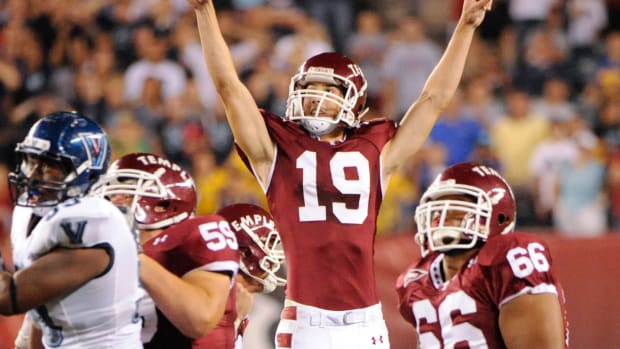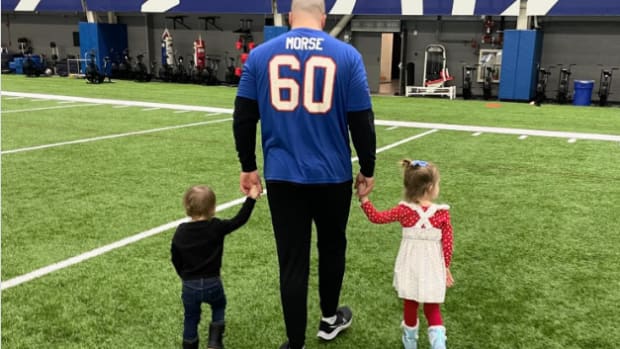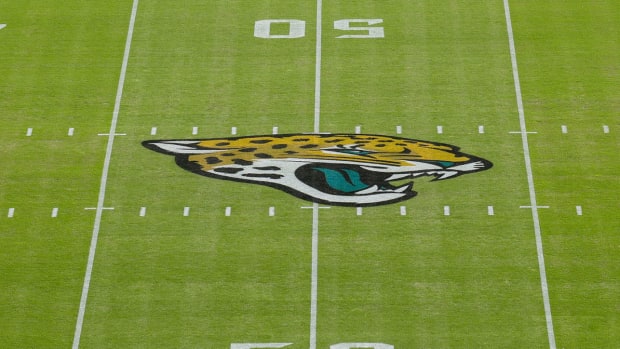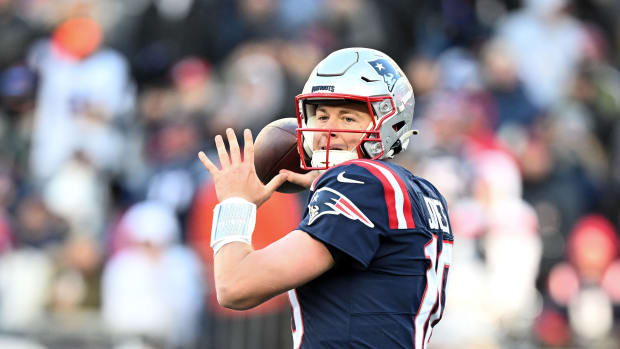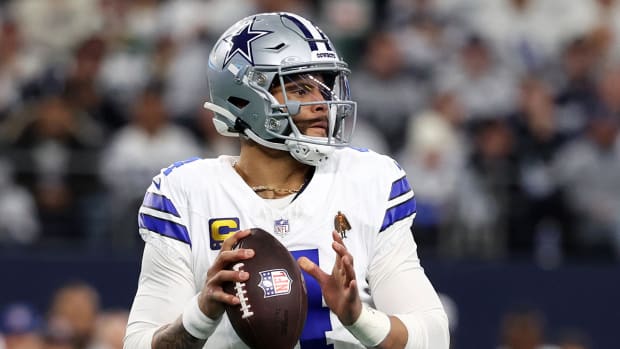Sky Is the Limit: Examining Laviska Shenault’s Outlook in the Jaguars’ Offense Moving Forward
There is a lot of optimism surrounding the Jacksonville Jaguars moving forward. Following the hiring of new head coach Urban Meyer, the energy around the Jaguars and the future outlook of the team and its stars has shifted.
Among those whose outlook could potentially benefit the most from Meyer's hiring? Wide receiver Laviska Shenault Jr.
Shenault finished his rookie campaign with 58 receptions, 600 receiving yards, and five touchdowns in 14 games played (12 starts). The 2020 second-rounder led Jacksonville in catches and touchdowns while ranking third in targets and yards.
His first NFL season is somewhat of a forgetful one, which comes with having injuries cut into playing time and being part of a 1-15 team. But Shenault still had a strong year, as he finished top-8 among rookies in every major receiving statistic among a loaded draft class that featured blue-chip prospects like CeeDee Lamb and Jerry Jeudy and breakout stars like Justin Jefferson and Chase Claypool.
It was especially encouraging to see Shenault finish strong, as he ended the season with three touchdowns in the last two games and recorded five-plus catches in each contest of the final month. Shenault ended up pacing the team in passer rating when targeted as a result of his high catch rate (75.3%) and late-season touchdown barrage.
The 2021 offseason will be a franchise-altering one, as it brought Meyer last week and will almost certainly bring a new quarterback in Trevor Lawrence in April. The entire team has nowhere to go but up, including Shenault. Here’s a more detailed review of his 2020 season and what to look for in the future.
Receiving Usage
Shenault’s 6.2 average depth of target was the lowest on the team among all non-running backs, which was mostly a result of his overall route tree, but also due to his involvement in the screen game. He caught all nine of his screen targets, but those plays went for just 45 yards and three first downs with an average Expected Points Added (EPA) of 0.09. Shenault’s non-screen receptions, on the other hand, resulted in 11.3 yards and 0.96 EPA per play.
When Shenault wasn’t being used in the screen game or as a rusher (more on that later), the majority of his targets came in the short-to-intermediate areas of the field. Of his 79 total targets, a remarkable 69 were less than 15 yards downfield (88%). D.J. Chark, Keelan Cole, and Chris Conley’s rate of deep targets were each more than double that of Shenault’s.
In other words, Shenault was seldom used in the deep passing game, which is unfortunate because he was really good at it. Shenault ranked first in touchdowns and success rate, and second in yards and EPA per target (behind Collin Johnson), among all Jaguars with multiple deep targets last season. Among 119 NFL players with 10-plus such targets, he ranked 17th in success rate and 21st in EPA per play.
Shenault’s sample size is small, but the fact that he hauled in all six of his deep catchable targets certainly gives him a case to see more work downfield next season.
According to numberFire, Shenault’s most targeted route last season was a curl. He caught 13 of 14 such targets for 134 yards and 0.76 EPA per play. Shenault’s incredible body control shows up on these plays, which allows him to have a wide catch radius, make contested catches and not go down easily.
Shenault has soft hands and strong legs, but his route running could use some work. He hasn’t shown the ability to separate from man coverage on the outside, and while he showed a better knack than he did in college for finding open grass against zone, that isn’t yet an area of proficiency either.
Given both his limited route running expertise and dangerousness in the open field with the ball in his hands, a larger slot role would likely make more sense for Shenault. He lined up in the slot on 27.3% of his routes last season, per Pro Football Focus, while Keelan Cole (who’s set to be an unrestricted free agent) led the team with a 69.4% slot rate.
Shenault averaged 1.72 yards per slot route compared to 1.48 yards per perimeter route, so he performed slightly better as an inside receiver. Something to monitor in the offseason is whether Jacksonville adds a starting-caliber wide receiver to the roster in free agency or the draft, and specifically, what type of receiver. Shenault does have the ability to play all over the field, but unless the Jaguars retain Cole or Dede Westbrook or add a true slot receiver, Shenault could become the main slot receiver in Jacksonville.
Rushing Usage
Shenault carried the ball 18 times in his rookie season, which was the fourth-most attempts by a wide receiver league-wide (behind Cordarrelle Patterson, Curtis Samuel and Robert Woods). He took a handoff from shotgun on 10 of those plays, handled a direct snap in Wildcat formation on two, and lined up as a receiver on the remainder.
Shenault didn’t make many big splashes in the run game, as his longest rush was 17 yards and just five of his 18 carries went for more than five yards- but he was still efficient, as he had a success rate of 50% to go with an average EPA of 0.059. Those numbers would rank sixth and 14th, respectively, among all players with 50-plus rushes in 2020. As with his deep receiving statistics, it’s a small sample size but encouraging nevertheless.
While Shenault has the physique to run inside, it may be best to get him outside and in space, where he can break tackles more easily and eat up yards after contact- he had 44 broken tackles from 2018 to 2019 at the University of Colorado, which led his draft class per PFF, and his eight broken tackles in 2020 ranked 11th among all NFL players. Shenault averaged 6.9 yards per carry when he made it outside the numbers last season but averaged 3.6 yards per carry on inside rushes.
With Urban Meyer now in town, Shenault’s rushing game has massive potential. One of Meyer’s offensive philosophies is to get the ball into the hands of his playmakers, and he did just that with weapons like Percy Harvin and Curtis Samuel at Florida and Ohio State, respectively.
Harvin and Samuel were both used all over the field and in multiple facets of the game- they each finished their collegiate careers with over 100 receptions and 150 rushes.
Meyer’s scheme was gap-based at Florida but transitioned to more zone blocking at Ohio State, and that is seen in the usage of these two players. When Harvin lined up in the backfield, most of his rushes were counter runs or speed options, with Wildcat, quick pitches and halfback sweeps mixed in. On the other hand, Samuel (who played both running back and wide receiver in college) was chiefly dealt halfback sweep, read option and speed option carries.
Another one of Meyer’s philosophies is to employ the quarterback as a rusher in order to ‘re-equate numbers.’ This strategy makes sense, and mobility has become one of the most important traits for a quarterback to have in today’s league, but it’s also unwise to initiate too much contact to a franchise player. Lawrence will certainly be used in the run game, but it wouldn’t be a surprise to see Shenault take a number of Wildcat snaps to run quarterback power or read options in order to preserve Lawrence’s body, especially in short-yardage and/or goal-line situations.
While there will likely be a couple of backfield packages, Shenault’s usage on jet sweeps and motions may be more vital. If Shenault is able to prove himself as a threat on those plays, then it will give pause to opposing linebackers and edge players and open holes both in the run game for James Robinson and in the passing game for Lawrence.
It’s unclear at this point exactly how Shenault will be utilized, as it’s to be determined how much the offense will look like Meyer’s college schemes as opposed to reported offensive coordinator Darrell Bevell’s playbook and it’s possible that Jacksonville could add another gadget-type player in the offseason- but Shenault will definitely get a number of schemed looks and benefit from Meyer’s creativity no matter what.
Final Outlook
“Encouraging” may be the best one-word reflection of Laviska Shenault’s opening NFL season. 36% of his touches last season were schemed through either screens or carries, and with better play design and blocking, those plays could turn from oohs and aahs to T’s and D’s. And while he isn’t yet as threatening as a perimeter receiver, Shenault has shown enough positive traits on film that with full health and more downfield usage he could become the 1B to D.J. Chark’s 1A (especially if he gets turned loose in the slot).
At the end of the day, Shenault is an exciting young athlete. If utilized properly in ways that maximize his strengths, he could turn into a walking highlight reel and perhaps even a star of the league.
Fortunately for him, Urban Meyer is one of the best coaches around to do just that, and Trevor Lawrence will be an immediate/massive upgrade to Jacksonville’s current quarterback room of misfit toys. The sky is the limit for Shenault in 2021 and beyond.
